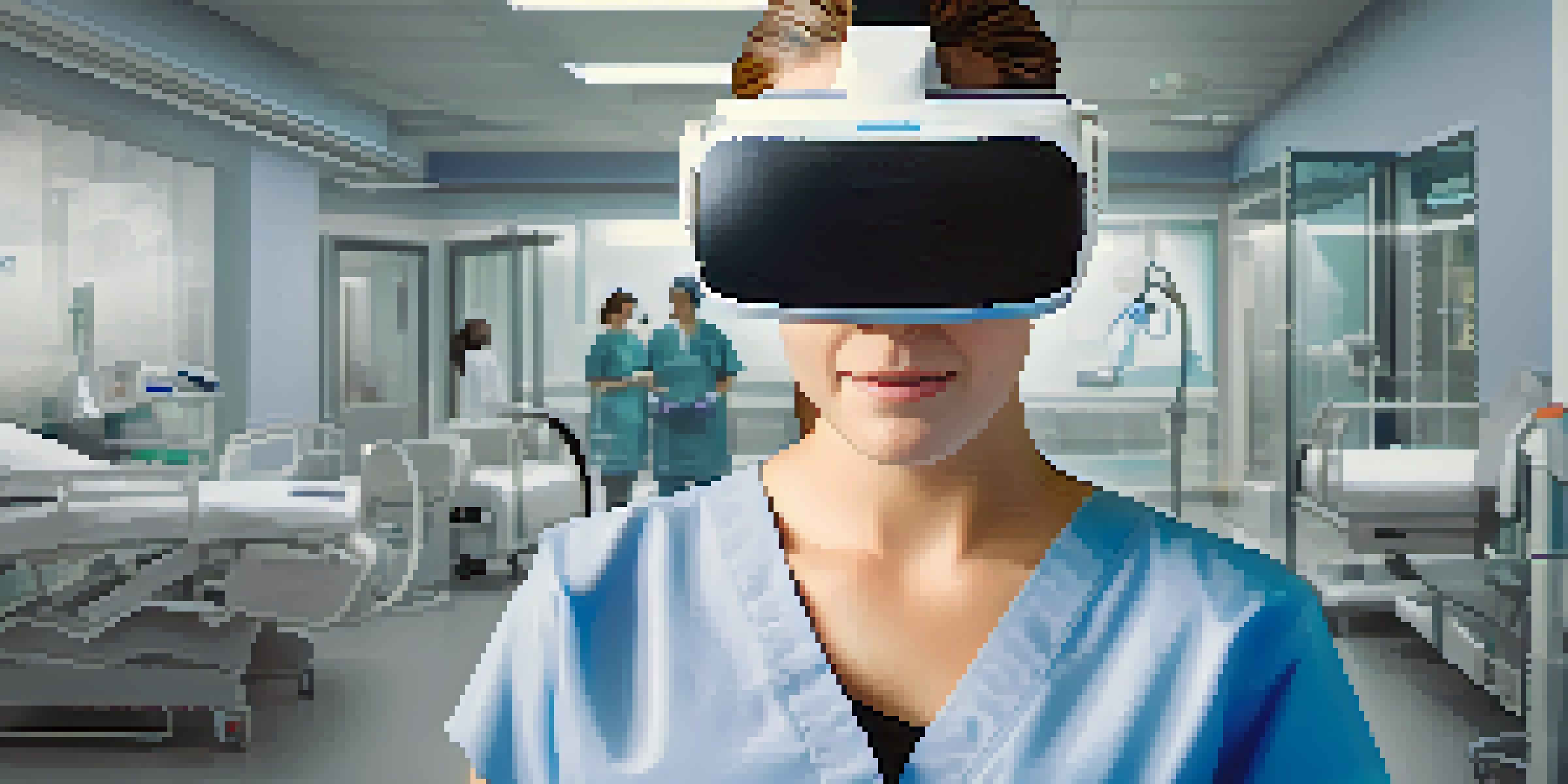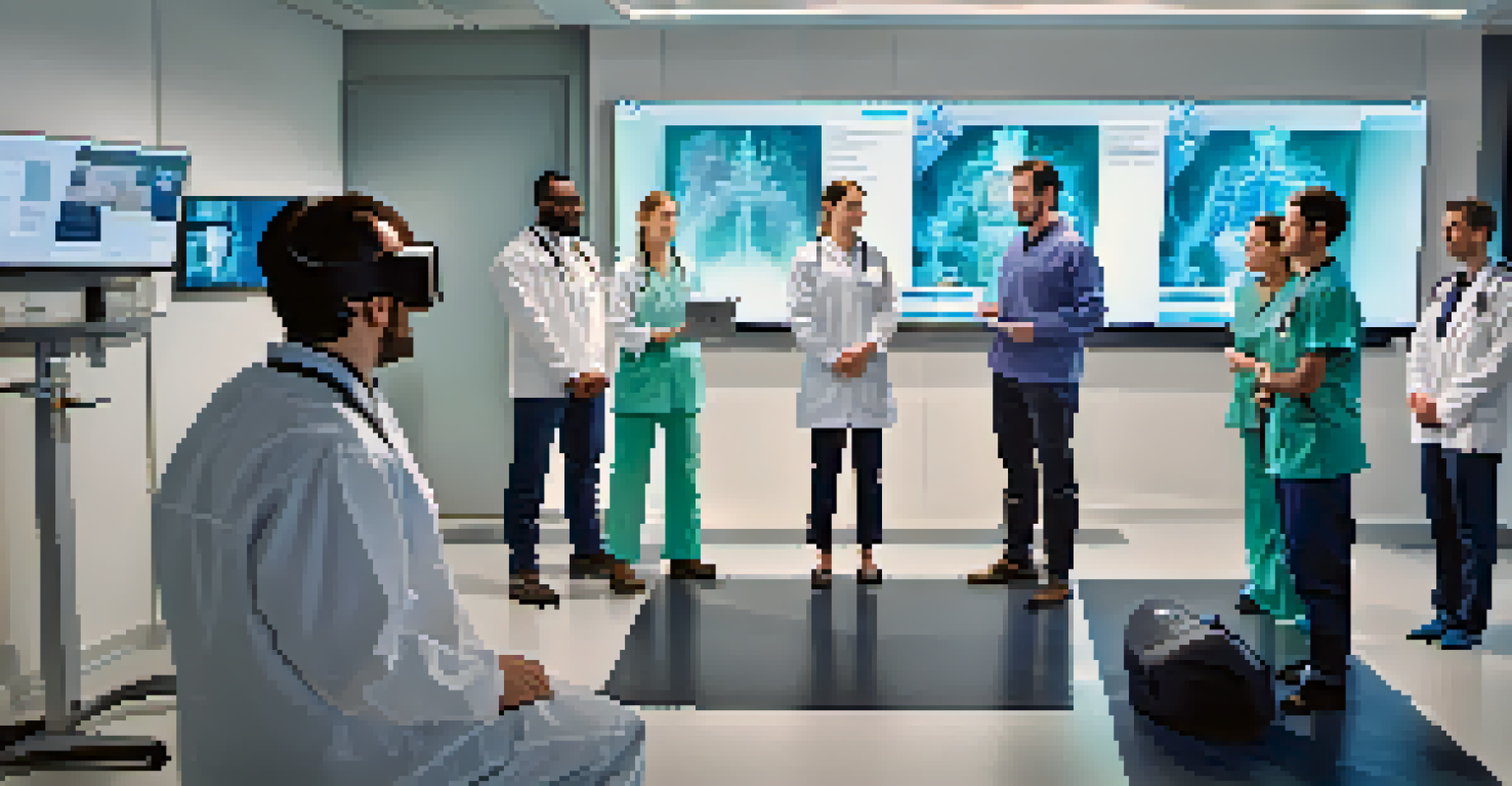Revolutionizing Healthcare Training with Immersive VR Simulations

Understanding Immersive VR: A New Frontier in Training
Immersive virtual reality (VR) is reshaping the way we approach training in various fields, especially healthcare. Unlike traditional methods, VR places learners in realistic, interactive environments, making the experience more engaging. Imagine a nursing student practicing patient care in a 3D simulation, allowing them to hone their skills without the risks involved in real-life scenarios.
Virtual reality is not just a tool for entertainment; it has the potential to transform education and training across various fields, particularly in healthcare.
This technology offers a safe space for learners to make mistakes and learn from them, which is crucial in healthcare where stakes are high. By immersing trainees in lifelike situations, they can develop critical thinking and decision-making skills. The beauty of VR is that it can replicate complex scenarios, from emergency room situations to routine check-ups, all designed to enhance learning outcomes.
As we look to the future, VR is not just a trend but a vital tool that’s likely to become standard in healthcare education. It provides a unique blend of theory and practice that can significantly boost confidence and competence among healthcare professionals. This revolutionary approach is paving the way for a new generation of skilled practitioners.
Benefits of VR Simulations in Healthcare Training
The benefits of using VR in healthcare training are numerous and impactful. Firstly, it allows for repetition and mastery of skills, enabling learners to practice procedures until they feel confident. This kind of experiential learning is invaluable, as it mimics real-life situations without the pressure of actual patient care.

Another significant advantage is the ability to customize training scenarios. Training programs can be tailored to meet the specific needs of different healthcare roles, ensuring that each learner receives relevant and targeted experience. For instance, a surgeon can practice intricate surgical techniques, while a paramedic can simulate emergency responses, all within a controlled environment.
VR Enhances Healthcare Training
Immersive VR provides realistic training environments that improve skills and confidence among healthcare professionals.
Furthermore, VR can significantly reduce training costs in the long run. By minimizing the need for physical materials and resources, healthcare institutions can allocate funds more efficiently. Additionally, fewer errors during training can lead to better patient outcomes, ultimately saving time and resources in real-world applications.
Enhancing Patient Safety Through VR Training
Patient safety is a top priority in healthcare, and VR training plays a pivotal role in enhancing it. By allowing healthcare professionals to practice and perfect their skills in a simulated environment, the chances of errors in real-life situations are significantly reduced. Imagine a scenario where a new surgical technique can be practiced repeatedly in VR before it's applied to actual patients.
The future of medicine is not just about technology; it's about using technology to improve the human experience in healthcare.
Moreover, VR training can help in preparing healthcare workers for high-stress situations, such as emergencies. Through immersive simulations, they can learn to remain calm and make quick decisions under pressure, which is critical in saving lives. This preparation is key to bridging the gap between theoretical knowledge and practical application.
As healthcare evolves, the emphasis on patient safety continues to grow. By investing in VR training, institutions can foster a culture of safety, where medical professionals are better equipped to handle challenges. This not only benefits the professionals but ultimately leads to improved patient care and outcomes.
Real-World Applications of VR in Medical Training
Real-world applications of VR in medical training are already making waves across the globe. For instance, medical schools are incorporating VR modules into their curricula, allowing students to practice surgeries and diagnostics virtually. This hands-on approach helps students transition smoothly from classroom learning to clinical practice.
Additionally, hospitals are using VR for ongoing training of their staff, ensuring that even seasoned professionals can stay updated with the latest techniques and protocols. With the rapid advancements in medical technology, continuous learning is essential, and VR provides a convenient platform for this. Staff can engage in refresher courses that fit into their busy schedules, enhancing their skills without disrupting their work.
Patient Safety is Prioritized
By allowing healthcare workers to practice in simulated scenarios, VR training significantly reduces the likelihood of errors in real-life situations.
Furthermore, VR is not limited to just technical skills; it also aids in soft skills training, such as communication and empathy. By simulating patient interactions, healthcare workers can practice their bedside manner and improve their patient relationships. This holistic approach to training ultimately leads to a better healthcare experience for everyone involved.
Challenges and Limitations of VR in Healthcare Training
While the potential of VR in healthcare training is immense, it's essential to recognize the challenges and limitations it presents. One major hurdle is the cost of developing and implementing VR programs, which can be a barrier for smaller institutions. Although prices are gradually decreasing, the initial investment can still be daunting for many.
Technical issues can also pose a challenge, as not all healthcare facilities have the necessary infrastructure to support immersive VR technologies. Connectivity issues or inadequate hardware can disrupt training sessions and dampen the learning experience. Ensuring that facilities are equipped with the right tools is crucial for the successful integration of VR in training programs.
Lastly, there’s the need for proper training for instructors and facilitators who will be using these technologies. Without a solid understanding of how to leverage VR effectively, the potential benefits could be lost. As with any new technology, ongoing education and support for educators are essential to maximize the impact of VR in healthcare training.
The Future of VR in Healthcare Education
Looking ahead, the future of VR in healthcare education is filled with promise and potential. As technology continues to advance, we can expect even more sophisticated simulations that offer unparalleled training experiences. Imagine virtual environments that can adapt in real-time based on a learner’s performance, providing personalized feedback and challenges.
Moreover, as VR becomes more mainstream, we may see the integration of artificial intelligence (AI) to further enhance learning. AI can analyze a trainee's performance data and suggest tailored training paths, ensuring that each individual gets the most out of their VR experience. This kind of adaptive learning could revolutionize how healthcare professionals train and prepare for real-world scenarios.
Customizable Learning Experiences
VR allows for tailored training programs that meet the specific needs of various healthcare roles, ensuring relevant and targeted skill development.
Finally, as the acceptance of VR in education grows, we’ll likely see an increase in collaborative training opportunities. Healthcare professionals from various disciplines could engage in joint simulations, fostering teamwork and interprofessional collaboration. This holistic approach to training is essential in today’s interconnected healthcare landscape, ultimately leading to better patient care.
Conclusion: Embracing VR for Better Healthcare Training
In conclusion, immersive VR simulations are revolutionizing healthcare training by providing engaging, practical, and safe learning environments. The benefits of this technology are clear: improved skills, enhanced patient safety, and tailored training experiences. As more institutions recognize the value of VR, we can expect to see widespread adoption across the healthcare sector.
While challenges remain, the potential for VR to transform education is too significant to ignore. By investing in this innovative training method, healthcare organizations can prepare their professionals for the complexities of modern medicine. As we embrace these advancements, we move closer to a future where healthcare training is not only effective but also enjoyable.

Ultimately, the integration of VR in healthcare training is a step towards creating a more skilled, confident, and prepared workforce. As we continue to explore and refine this technology, the impact on patient care and outcomes will undoubtedly be profound. It’s an exciting time for healthcare education, and VR is leading the way.